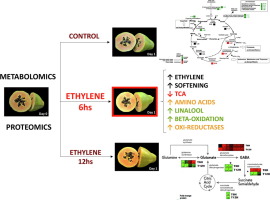Food Research International ( IF 7.0 ) Pub Date : 2020-01-03 , DOI: 10.1016/j.foodres.2019.108975 Roberta Ghedini Der Agopian , João Paulo Fabi , Beatriz Rosana Cordenunsi-Lysenko

|
Papayas undergo fast postharvest changes triggered by the plant hormone ethylene. Some important pathways have been analyzed in limited studies (transcriptomics and targeted metabolomics); however, broad use of proteomics or untargeted metabolomics have not yet been used in papayas. In this study, two groups of green papayas (150 days after anthesis—physiological maturity for papayas) were treated with ethylene at different times (6 and 12 hours) and their metabolic changes in fruit pulp were evaluated with untargeted metabolomics (general metabolites and volatile compounds) and proteomics. Polar metabolites exhibited distinct patterns, especially with regard to some amino and fatty acids during stimulated ripening. In particular, glutamate increased through a possible gamma aminobutyric acid (GABA) shunt and/or proteases activity. Moreover, the stimulated ripening altered the volatile compounds and the protein profiles. The results suggest that changes in membrane breakdown and the resulting oxidative processes could be responsible for volatile compound production, altering some sensorial qualities of papayas, such as pulp softening and the specific papaya linalool volatile compound increment. Thus, GABA levels could also be a strong biological marker for papaya development and ripening stages. This study applied two “omic” techniques that provided insight into how the plant hormone ethylene could influence papaya postharvest quality.
中文翻译:

乙烯处理的木瓜的代谢组和蛋白质组揭示了挥发性化合物生物合成的不同途径
番木瓜会因植物激素乙烯而快速发生采后变化。在有限的研究中已经分析了一些重要的途径(转录组学和靶向代谢组学);但是,尚未在木瓜中广泛使用蛋白质组学或非靶向代谢组学。在这项研究中,两组青木瓜(花后150天-木瓜的生理成熟)在不同的时间(6和12小时)用乙烯处理,并用非目标代谢组学(一般代谢物和挥发性物质)评估了它们在果肉中的代谢变化。化合物)和蛋白质组学。极性代谢物表现出独特的模式,尤其是在刺激成熟过程中某些氨基酸和脂肪酸方面。特别地,谷氨酸通过可能的γ氨基丁酸(GABA)分流和/或蛋白酶活性而增加。此外,刺激的成熟改变了挥发性化合物和蛋白质谱。结果表明,膜破裂的变化和由此产生的氧化过程可能是挥发性化合物产生的原因,从而改变了木瓜的某些感官品质,例如纸浆软化和特定的木瓜芳樟醇挥发性化合物增加。因此,GABA水平也可能是木瓜发育和成熟阶段的强大生物标记。这项研究应用了两种“组学”技术,从而深入了解了植物激素乙烯如何影响番木瓜采后质量。改变木瓜的某些感官品质,例如纸浆软化和特定的木瓜芳樟醇挥发性化合物增加。因此,GABA水平也可能是木瓜发育和成熟阶段的强大生物标记。这项研究应用了两种“组学”技术,从而深入了解了植物激素乙烯如何影响番木瓜采后质量。改变木瓜的某些感官品质,例如纸浆软化和特定的木瓜芳樟醇挥发性化合物增加。因此,GABA水平也可能是木瓜发育和成熟阶段的强大生物标记。这项研究应用了两种“组学”技术,从而深入了解了植物激素乙烯如何影响番木瓜采后质量。











































 京公网安备 11010802027423号
京公网安备 11010802027423号